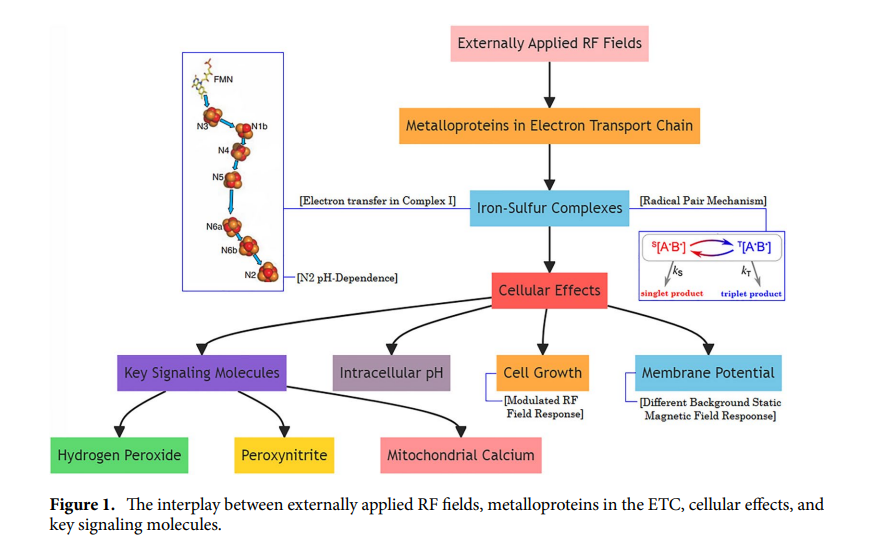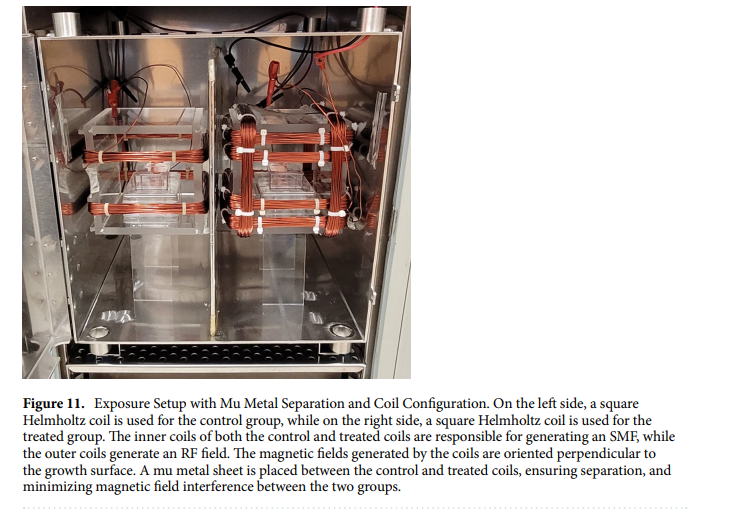
The study explores the Impact of weak radiofrequency and static magnetic fields on key signaling molecules, intracellular pH, membrane potential, and cell growth in HT-1080 fibrosarcoma cells, focusing on cell signaling molecules, intracellular pH, membrane potential, and cell growth. It investigates how these fields influence reactive oxygen species (ROS) and reactive nitrogen species (RNS) production, crucial for understanding their biological impacts.
The findings suggest that external magnetic fields, through hyperfine interactions and the modulation of Fe-S clusters, can alter cell physiology, potentially offering insights into aging, cancer, and other conditions. This research contributes to the broader understanding of electromagnetic field interactions with biological systems, highlighting the importance of further exploration in bioelectric research and safety standards.

The findings indicate a complex interplay between magnetic fields and biological systems, hinting at clinical implications for aging, cancer, arthritis, and Alzheimer’s disease. This research contributes to understanding how weak magnetic fields interact with biological systems, emphasizing the potential for magnetic field-mediated clinical applications.
HT-1080 fibrosarcoma cells are human cancer cells derived from a fibrosarcoma, a type of cancer that originates in the fibrous connective tissue. These cells are often used in research to study cancer biology, including mechanisms of tumor growth, metastasis, and the response to various treatments. Their use in this study helps explore how weak radiofrequency and static magnetic fields might affect cancer cell behavior, potentially opening new avenues for understanding and treating cancer.
The study found that weak radiofrequency and static magnetic fields, specifically at a frequency of 70 Hz and exposure levels up to 1 mT, can influence HT-1080 fibrosarcoma cells. These exposures affected intracellular pH, membrane potential, cell growth, and the concentrations of reactive oxygen species (ROS) and reactive nitrogen species (RNS). The research indicates that even weak magnetic fields can have significant biological effects, suggesting potential applications in clinical settings for diseases like cancer, where modulation of cell behavior could be therapeutic.

The document’s findings:
- Weak radiofrequency and static magnetic fields (70 Hz, up to 1 mT) affect fibrosarcoma cells.
- Influences include changes in intracellular pH, membrane potential, and cell growth.
- Alterations in reactive oxygen species (ROS) and reactive nitrogen species (RNS) concentrations observed.
Call to Action:
- Advance EMF Research: Encourage further studies to understand the mechanisms behind electromagnetic fields (EMF) interactions with biological systems.
- Develop Clinical Applications: Explore potential therapeutic applications of EMF in treating diseases like cancer, based on bioelectric research findings.
- Reevaluate Safety Standards: Use new insights to reassess EMF exposure guidelines, ensuring they reflect the latest scientific knowledge on bioelectric effects on human health.
Another study by Bachmann et al. (2007) in “The Environmentalist” investigated the effects of low-level microwaves modulated at 40 Hz and 70 Hz on human EEG signals. Conducted on 15 volunteers, the research found significant changes in EEG patterns, particularly an increase in EEG beta power, indicating microwave exposure’s influence on brain activity. Notably, 26.7% of subjects showed statistically significant EEG changes at 40 Hz modulation frequency.